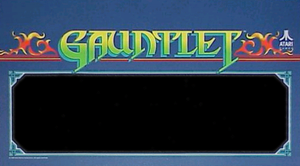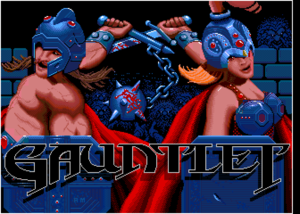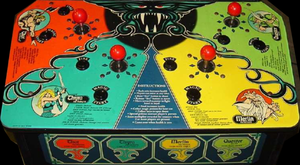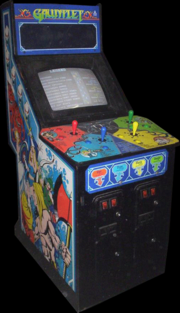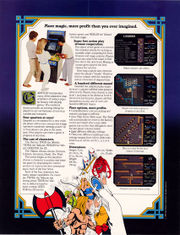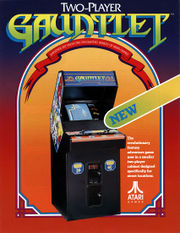Lost In Translation/Gauntlet
| Gauntlet | |
|---|---|
| Manufacturer | Atari Games |
| Released | 1985 |
| Control Method |
8-way Joystick 2 Button(s) |
| Main CPU | 68010 (@ 7.159 MHz) M6502 (@ 1.790 MHz) |
| Sound CPU | Stereo YM2151 (@ 3.580 MHz) POKEY (@ 1.790 MHz) TMS5220 (@ 650.826 kHz) |
| Video Details |
Raster (Horizontal) 336 x 240 pixels 59.92 Hz 1,024 Palette colours |
| Screens | 1 |
| ROM Info | 20 ROMs 484,608 bytes (473.25 KiB) |
| MAME ID | gauntlet · gaun2pg1 · gaun2pj2 · gaun2pr3 · gaunt2p · gaunt2pg · gaunt2pj · gauntg · gauntgr3 · gauntgr6 · gauntgr8 · gauntj · gauntj12 · gauntr1 · gauntr2 · gauntr4 · gauntr5 · gauntr7 · gauntr9 · gaunts |
About The Game
Gauntlet is an arcade video game where up to 4 players cooperatively explore a multitude of mazes. As players cooperate to fight off common enemies and try to find their way out of the various mazes, they must also compete with each other for food, treasure, magic potions and other helpful items.
The player controls consist of an 8-position joystick that moves the player's character and directs fire. While the Fire button is pressed, the player's character stops; the player then selects the direction of fire with the joystick. Each player is allowed one shot at a time. If the Fire button is held down, it will repeat fire as fast as possible.
The player can collect and save magic potions for later use by touching them with his character. The player can press the Magic button when he wants to use the potions he has collected.
Up to 4 players can play at once. Each new player can enter a game at any time. Each player chooses one of 4 available characters : Thor the Warrior, Thyra the Valkyrie, Merlin the Wizard, or Questor the Elf. Each of these characters has unique capabilities. For instance, Thyra has great armor, Thor is best at hand-to-hand combat, while Questor has the fastest speed, and Merlin has the best ability to use magic. Complete character descriptions are included on the Gauntlet control panel.
The action begins as the player(s) choose a character and enter the game by depositing coins or tokens in the proper slot. One coin slot is designated for each of the four unique characters : Thor the Warrior (coin slot on the far left marked with red), Thyra the Valkyrie (blue coin slot to the left of center), Merlin the Wizard (yellow coin slot to the right of center), and Questor the Elf (green coin slot to the far right).
The object of the game is to survive as long as possible while exploring each maze to find food, treasure, and magic potions. Players must search the maze to find the exit to the next level. Playing as a team will give the players the best chance for survival.
At level 1, players will find exits going to other levels. If the players choose, they may exit level 1 and jump as far ahead as level 8 and skip six levels. The first seven mazes are always the same. On level 8 and beyond, players will find themselves on any one of over a hundred different mazes. If a player survives long enough, mazes will be repeated in a different order to provide uninterrupted entertainment.
How long a player lasts (game time) depends upon the player's 'health'. Health is lost by contact with various monsters and as a function of elapsed time. Health can be regained or increased by consuming the food found in the maze or by depositing more coins. Thus, a player can continue to play and explore more and more mazes.
In addition to consuming food for health, players can collect treasure for points. Treasure increases a player's score multiplier when 2 or more players are playing the game.
In addition, magic potions affect all the enemies on the screen. These magic potions can be held for later use when many enemies can be destroyed at once. The magic potion is the only weapon that can kill the awesome Death.
Players can find certain magic potions that strengthen their character with extra speed, extra armor, etc. These strengths will remain with the character (until the Thief steals them or the player's health reaches zero) and are an incentive for players to keep depositing coins to play the game. Once a strong character is built up, a player can play longer for each unit of health.
Gauntlet incorporates many of the attractive characteristics of popular fantasy role-playing games. The medieval theme provides a setting for players to act out fantasies of combat and conquest.
Additional Technical Information
Players : 4
Control : 8-way joystick
Buttons : 2 (Fire, Magic Potion)
Trivia
Released in December 1985.
Gauntlet was originally going to be called 'Dungeons' and was inspired not only by TSR's tabletop RPG, 'Dungeons & Dragons', but also by another Atari game called 'Dandy'. Dandy's creator, Jack Palevich, tried fruitlessly to get his name added to the list of credits in Gauntlet. In lieu of public recognition, Atari Games Corp gave Pelvich a Gauntlet cabinet, and he in turn agreed not to sue Atari.
Gauntlet's revolutionary, non-linear game-play gave players multiple choices, as they were no longer forced into taking a linear route through the game. Like 'Dungeons & Dragons', Gauntlet players could choose their own path, searching for keys, treasures, food and transporters to take them to other levels. Unlike most other games at the time, the player didn't always have to fight; a simpler route through the dungeon could sometimes be found, or players could simply try to make a run for it.
Another Gauntlet milestone was in the game's use of sound effects. Synthesized human voices had been used sporadically in games in the early eighties and while it had proved, on most occasions, to be moderately successful, was still considered something of a novelty. Gauntlet, however, revolutionized the concept of in-game speech and added immeasurably to the game's superb atmosphere. The deep timbre of Gauntlet's very own 'Dungeon Master' would guide players through the levels, informing them that 'Elf needs food, badly', or that 'Blue Wizard is about to die' and the always-good advice that is 'Don't shoot food.'
Note : The game contains exactly 212 sounds (including synthesized voices, effects and musics).
Approximately 8,000 units were produced.
Note : There were 20 officially released versions (see Updates section for detailed info), including 6 '2-player' versions and various Spanish, German and Japanese versions. Counting 4-players English variants alone, there were 7 releases with various bug-fixes.
The default high score screen of "Cyberball 2072" features names of many Atari arcade games, including GAUNTLET.
Charles Nagle holds the official record for this game with 4,401,169 points on March 28, 2003.
Pony Canyon / Scitron released a limited-edition soundtrack album for this game (That's Atari Music Vol.II : G.S.M. Atari Games 2 - PCCB-00070) on 21/09/1991.
Updates
Revision 1 (4-players)
- First world release.
Revision 2 (4-players)
- Added an option called 'Disable Speech?' in the operator menu.
- Fixed some texts in attract mode.
Revision 3 (4-players)
- German release only.
Revision 4 (4-players)
- World release.
Revision 5 (4-players)
- World release.
Revision 6 (4-players)
- German release only.
- Added 'All walls turn into exits' trick (see 'Tips And Tricks' section).
- Added ability to stop the attract mode with the fire button.
Revision 7 (4-players)
- World release.
Revision 8 (4-players)
- German release only.
- Added an option called 'Reduce Text?' in the operator menu.
Revision 9 (4-players)
- World release.
- Levels are different : Level 9 and 10 are removed (Level 12 on revision 8 = Level 10 on revision 9).
Revision 10 (4-players)
- German release only.
Revision 12 (4-players)
- Japanese release only.
Revision 13 (4-players)
- Japanese release only.
Revision 14 (4-players)
- World release.
Revision 15 (4-players)
- Spanish release only.
Revision 1 (2-players)
- German release only.
- Based on the lastest 4-players revision.
Revision 2 (2-players)
- Japanese release only.
Revision 3 (2-players)
- World release.
Revision 4 (2-players)
- German release only.
Revision 5 (2-players)
- Japanese release only.
Revision 6 (2-players)
- World release.
Tips and tricks
- Hints for Game Play : The following hints will help you use your health more effectively and score more points per coin :
- Play cooperatively.
- Allow the player with the best ability to use magic (usually Merlin the Wizard, unless one of the other players has acquired the magic potion for extra magic) to pick up the magic potions.
- Save keys and potions and use them conservatively.
- Pay attention to your marching order. Allow the players with the best fighting ability and armor (usually Thyra the Valkyrie and Thor the Warrior) to lead the way and fend off attacks.
- Avoid contact with the ghosts : they take away your health very quickly and you cannot fight them hand-to-hand.
- If you remain motionless (or basically aimless) and stall off about 30 health, all of the doors will open. Everybody knows this, and the game even tells you about it. The game doesn't tell you that if you stall off about 200 health, all the walls will turn into exits! (work on Revision 6 and +) The game designers had to include this because there are some levels which require you to pick up a key before you exit. If you are already filled up with keys, and the doors are all gone, then it would be IMPOSSIBLE for you to exit, and you would starve to death. What they didn't anticipate, is that certain levels of the game which are really difficult, which would require you to take massive health losses to finish, become very simple if all the walls are exits. Or they can be effectively skipped altogether. Because the game has Monty-Hall levels with lots of food on them, you can use this cheat to only play levels which are a wash or increase your health dramatically, and cut your losses to 200 on all the really hard levels.
- The best character to play, in the LONG run, is the elf. His magic is just as good as the wizard's and his fight ability as good as Thor's. His ability to shoot through cracks in addition to all this (when he has the power potions) makes him the best. The Valkyrie is the worst, although some people regard this as a challenge...
- To manipulate the point value of Death, shoot him. Death's point value takes the following progression : 1000-2000-1000-4000-1000-6000-1000-8000, and then back to start. His value keeps from the previous game.
- You can kill Death painlessly by teleporting on top of him.
- Level 8 is the level that the previous game ended on. If you got a really good sequence of boards in a game and you want to repeat them, turn the machine off and on again after you've entered your high score.
Series
- Gauntlet (1985)
- Gauntlet [PlayChoice-10] (1985)
- Gauntlet II (1986)
- Gauntlet - The Third Encounter (1990, Atari Lynx)
- Gauntlet III - The Final Quest (1991)
- Gauntlet 4 (1993, Sega Mega Drive)
- Gauntlet Legends (1998)
- Gauntlet Dark Legacy (1999)
- Gauntlet Seven Sorrows (2006, Sony PlayStation 2 & Microsoft XBOX)
Staff
- Designer / Programmer
- Ed Logg (ED )
- Game Programmer
- Bob Flanagan (BF )
- Video Graphics
- Sam Comstock (SWC)
- Susan G. McBride (SGM)
- Alan Murphy
- Will Noble
- Dave Pettigrew (D F)
- Engineer
- Pat McCarthy (PMC)
- Technician
- Sae Oh (SMO)
- Cris Drobny (CAD)
- Sound Designers
- Hal Canon (HAL)
- Earl Vickers (EAR)
- Cabinet Designer
- Ken Hata (KEN)
Cabinet and Artwork
Ports
- Consoles
- Atari Lynx (1990)
- Sega Master System (1990)
- Sega Mega Drive
- Sony PlayStation (1998, "Arcade's Greatest Hits - The Atari Collection 2")
- Sega Dreamcast (2000, "Midway's Greatest Arcade Hits Volume 2")
- Sony PlayStation 2 (2003, "Midway Arcade Treasure")
- Nintendo GameCube (2003, "Midway Arcade Treasure")
- Microsoft XBOX (2003, "Midway Arcade Treasure")
- Sony PSP (2005, "Midway Arcade Treasures - Extended Play")
- Nintendo Game Boy Advance (2005, "Gauntlet / Rampart")
- Microsoft XBOX 360 (2005, as a downloadable Live Arcade game)
- Computers
- Atari XL/XE (1985)
- Amstrad CPC (1985)
- Atari ST (1985)
- Commodore C64 (1986)
- Tandy Color Computer (1986, "Gantelet")
- Sinclair ZX Spectrum (1987)
- Apple II (1988)
- PC [MS-DOS] (1988)
- PC [MS Windows, CD-ROM] (1998, "Arcade's Greatest Hits - The Atari Collection 2")
- PC [MS Windows, CD-ROM] (2004, "Midway Arcade Treasure")
- Others
- LCD handheld game (1988) released by Tiger Electronics
Soundtrack Releases
| Album Name | Catalogue No. | Released | Publisher | Comments |
|---|---|---|---|---|
| That's Atari Music Vol.II -G.S.M. ATARI GAMES 2- | PCCB-00070[1] | 1991-09-21 | Pony Canyon/Scitron | CD version. |
| That's Atari Music Vol.II -G.S.M. ATARI GAMES 2- | SCDC-00314[2] | 2003-12-03 | Scitron Digital Content Inc. | CD version. |
| Arcade Ambiance 1986 | N/A[3] | 2004-08-27 | Andy Hofle | Digital download only. |
Sound Comparison
| Platform | Song Titles | Sound Source | |||||
|---|---|---|---|---|---|---|---|
| Arcade | "Title Screen / Continue" | "Stage Start" | "Treasure Room 1" | "Treasure Room 2" | "Treasure Room 3" | "Treasure Room 4" | M1 v0.7.8a6 |
External Links
- Sinclair ZX Spectrum version of Gauntlet at the World of Spectrum
- Sinclair ZX Spectrum version of Gauntlet: The Deeper Dungeons at the World of Spectrum


